Roehampton University: Reflective Journal on Group Presentations
VerifiedAdded on 2023/06/14
|5
|942
|226
Journal and Reflective Writing
AI Summary
This reflective journal reflects on the process of group presentations, specifically focusing on teamwork and communication skills within a diverse group at Roehampton University. The journal explores the challenges and strategies used during team preparation, emphasizing the importance of mutual respect and effective communication. It also delves into the anxieties associated with presenting findings to an audience and the significance of audience engagement and appropriate gestures. The author reflects on the strategies employed to overcome communication barriers, manage different perspectives, and improve presentation skills, ultimately highlighting the lessons learned in teamwork and effective communication. The journal also acknowledges the importance of proper data collection and analysis, as well as the rehearsal of presentation methods for optimal delivery.
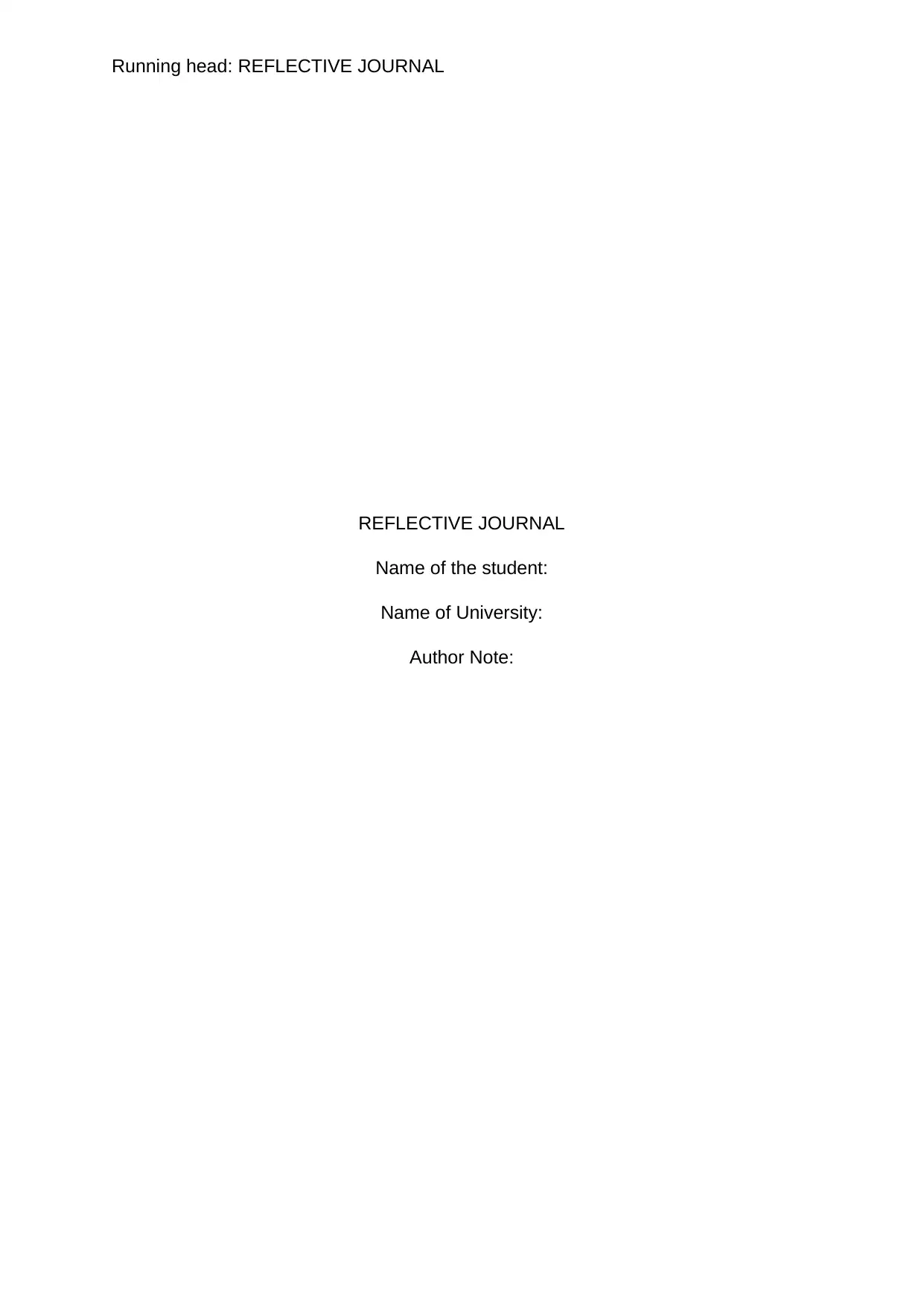
Running head: REFLECTIVE JOURNAL
REFLECTIVE JOURNAL
Name of the student:
Name of University:
Author Note:
REFLECTIVE JOURNAL
Name of the student:
Name of University:
Author Note:
Paraphrase This Document
Need a fresh take? Get an instant paraphrase of this document with our AI Paraphraser
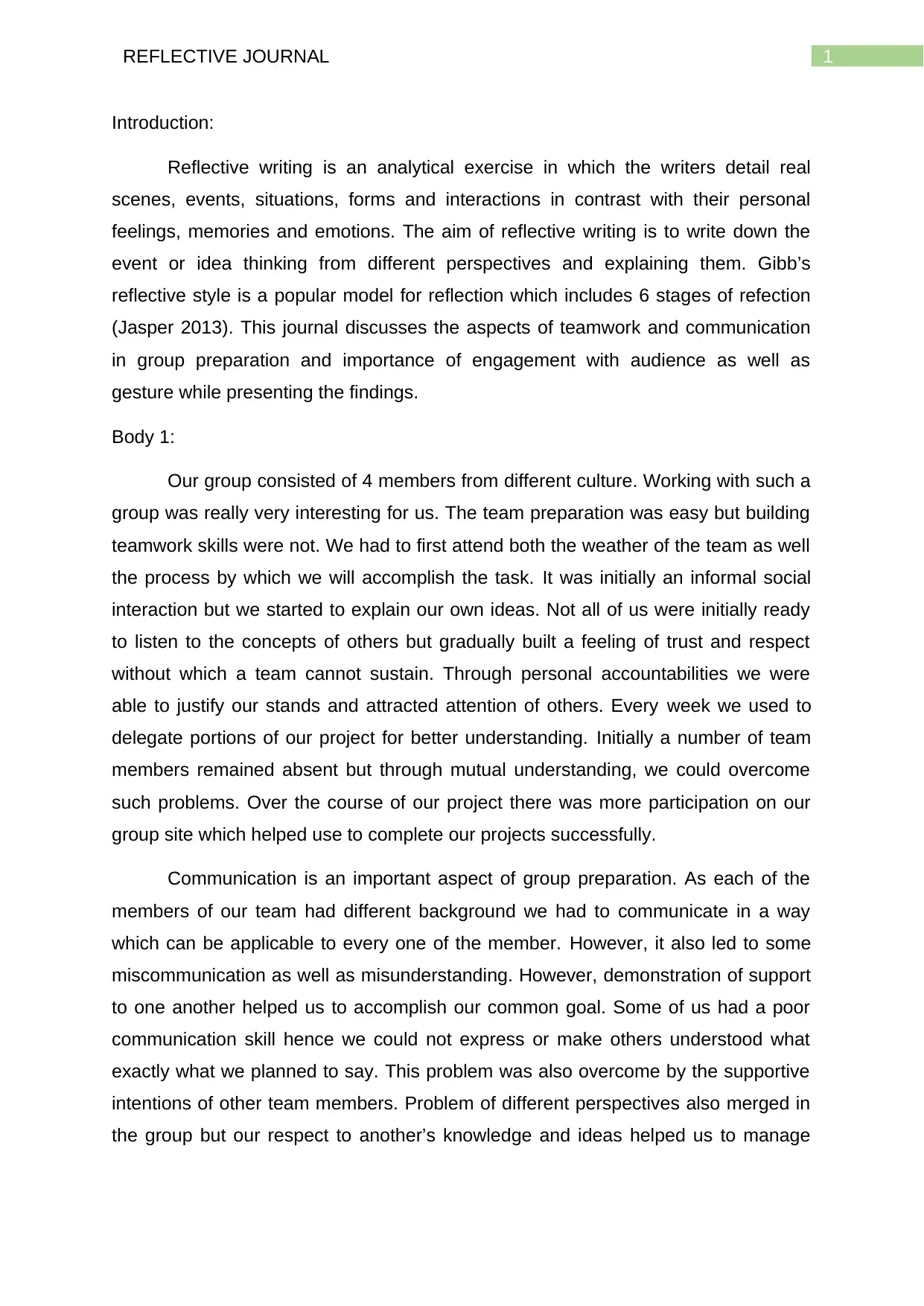
1REFLECTIVE JOURNAL
Introduction:
Reflective writing is an analytical exercise in which the writers detail real
scenes, events, situations, forms and interactions in contrast with their personal
feelings, memories and emotions. The aim of reflective writing is to write down the
event or idea thinking from different perspectives and explaining them. Gibb’s
reflective style is a popular model for reflection which includes 6 stages of refection
(Jasper 2013). This journal discusses the aspects of teamwork and communication
in group preparation and importance of engagement with audience as well as
gesture while presenting the findings.
Body 1:
Our group consisted of 4 members from different culture. Working with such a
group was really very interesting for us. The team preparation was easy but building
teamwork skills were not. We had to first attend both the weather of the team as well
the process by which we will accomplish the task. It was initially an informal social
interaction but we started to explain our own ideas. Not all of us were initially ready
to listen to the concepts of others but gradually built a feeling of trust and respect
without which a team cannot sustain. Through personal accountabilities we were
able to justify our stands and attracted attention of others. Every week we used to
delegate portions of our project for better understanding. Initially a number of team
members remained absent but through mutual understanding, we could overcome
such problems. Over the course of our project there was more participation on our
group site which helped use to complete our projects successfully.
Communication is an important aspect of group preparation. As each of the
members of our team had different background we had to communicate in a way
which can be applicable to every one of the member. However, it also led to some
miscommunication as well as misunderstanding. However, demonstration of support
to one another helped us to accomplish our common goal. Some of us had a poor
communication skill hence we could not express or make others understood what
exactly what we planned to say. This problem was also overcome by the supportive
intentions of other team members. Problem of different perspectives also merged in
the group but our respect to another’s knowledge and ideas helped us to manage
Introduction:
Reflective writing is an analytical exercise in which the writers detail real
scenes, events, situations, forms and interactions in contrast with their personal
feelings, memories and emotions. The aim of reflective writing is to write down the
event or idea thinking from different perspectives and explaining them. Gibb’s
reflective style is a popular model for reflection which includes 6 stages of refection
(Jasper 2013). This journal discusses the aspects of teamwork and communication
in group preparation and importance of engagement with audience as well as
gesture while presenting the findings.
Body 1:
Our group consisted of 4 members from different culture. Working with such a
group was really very interesting for us. The team preparation was easy but building
teamwork skills were not. We had to first attend both the weather of the team as well
the process by which we will accomplish the task. It was initially an informal social
interaction but we started to explain our own ideas. Not all of us were initially ready
to listen to the concepts of others but gradually built a feeling of trust and respect
without which a team cannot sustain. Through personal accountabilities we were
able to justify our stands and attracted attention of others. Every week we used to
delegate portions of our project for better understanding. Initially a number of team
members remained absent but through mutual understanding, we could overcome
such problems. Over the course of our project there was more participation on our
group site which helped use to complete our projects successfully.
Communication is an important aspect of group preparation. As each of the
members of our team had different background we had to communicate in a way
which can be applicable to every one of the member. However, it also led to some
miscommunication as well as misunderstanding. However, demonstration of support
to one another helped us to accomplish our common goal. Some of us had a poor
communication skill hence we could not express or make others understood what
exactly what we planned to say. This problem was also overcome by the supportive
intentions of other team members. Problem of different perspectives also merged in
the group but our respect to another’s knowledge and ideas helped us to manage
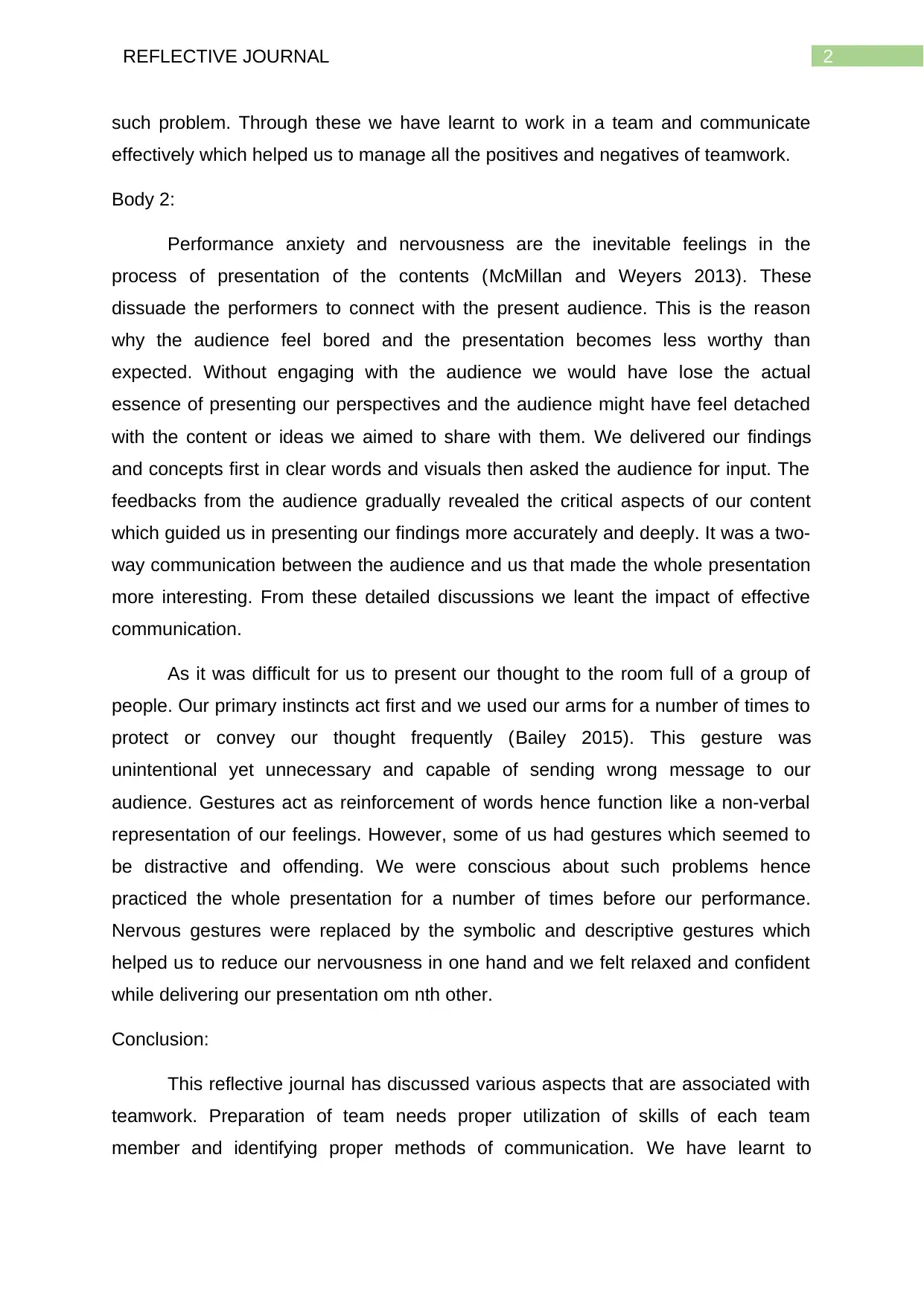
2REFLECTIVE JOURNAL
such problem. Through these we have learnt to work in a team and communicate
effectively which helped us to manage all the positives and negatives of teamwork.
Body 2:
Performance anxiety and nervousness are the inevitable feelings in the
process of presentation of the contents (McMillan and Weyers 2013). These
dissuade the performers to connect with the present audience. This is the reason
why the audience feel bored and the presentation becomes less worthy than
expected. Without engaging with the audience we would have lose the actual
essence of presenting our perspectives and the audience might have feel detached
with the content or ideas we aimed to share with them. We delivered our findings
and concepts first in clear words and visuals then asked the audience for input. The
feedbacks from the audience gradually revealed the critical aspects of our content
which guided us in presenting our findings more accurately and deeply. It was a two-
way communication between the audience and us that made the whole presentation
more interesting. From these detailed discussions we leant the impact of effective
communication.
As it was difficult for us to present our thought to the room full of a group of
people. Our primary instincts act first and we used our arms for a number of times to
protect or convey our thought frequently (Bailey 2015). This gesture was
unintentional yet unnecessary and capable of sending wrong message to our
audience. Gestures act as reinforcement of words hence function like a non-verbal
representation of our feelings. However, some of us had gestures which seemed to
be distractive and offending. We were conscious about such problems hence
practiced the whole presentation for a number of times before our performance.
Nervous gestures were replaced by the symbolic and descriptive gestures which
helped us to reduce our nervousness in one hand and we felt relaxed and confident
while delivering our presentation om nth other.
Conclusion:
This reflective journal has discussed various aspects that are associated with
teamwork. Preparation of team needs proper utilization of skills of each team
member and identifying proper methods of communication. We have learnt to
such problem. Through these we have learnt to work in a team and communicate
effectively which helped us to manage all the positives and negatives of teamwork.
Body 2:
Performance anxiety and nervousness are the inevitable feelings in the
process of presentation of the contents (McMillan and Weyers 2013). These
dissuade the performers to connect with the present audience. This is the reason
why the audience feel bored and the presentation becomes less worthy than
expected. Without engaging with the audience we would have lose the actual
essence of presenting our perspectives and the audience might have feel detached
with the content or ideas we aimed to share with them. We delivered our findings
and concepts first in clear words and visuals then asked the audience for input. The
feedbacks from the audience gradually revealed the critical aspects of our content
which guided us in presenting our findings more accurately and deeply. It was a two-
way communication between the audience and us that made the whole presentation
more interesting. From these detailed discussions we leant the impact of effective
communication.
As it was difficult for us to present our thought to the room full of a group of
people. Our primary instincts act first and we used our arms for a number of times to
protect or convey our thought frequently (Bailey 2015). This gesture was
unintentional yet unnecessary and capable of sending wrong message to our
audience. Gestures act as reinforcement of words hence function like a non-verbal
representation of our feelings. However, some of us had gestures which seemed to
be distractive and offending. We were conscious about such problems hence
practiced the whole presentation for a number of times before our performance.
Nervous gestures were replaced by the symbolic and descriptive gestures which
helped us to reduce our nervousness in one hand and we felt relaxed and confident
while delivering our presentation om nth other.
Conclusion:
This reflective journal has discussed various aspects that are associated with
teamwork. Preparation of team needs proper utilization of skills of each team
member and identifying proper methods of communication. We have learnt to
⊘ This is a preview!⊘
Do you want full access?
Subscribe today to unlock all pages.

Trusted by 1+ million students worldwide
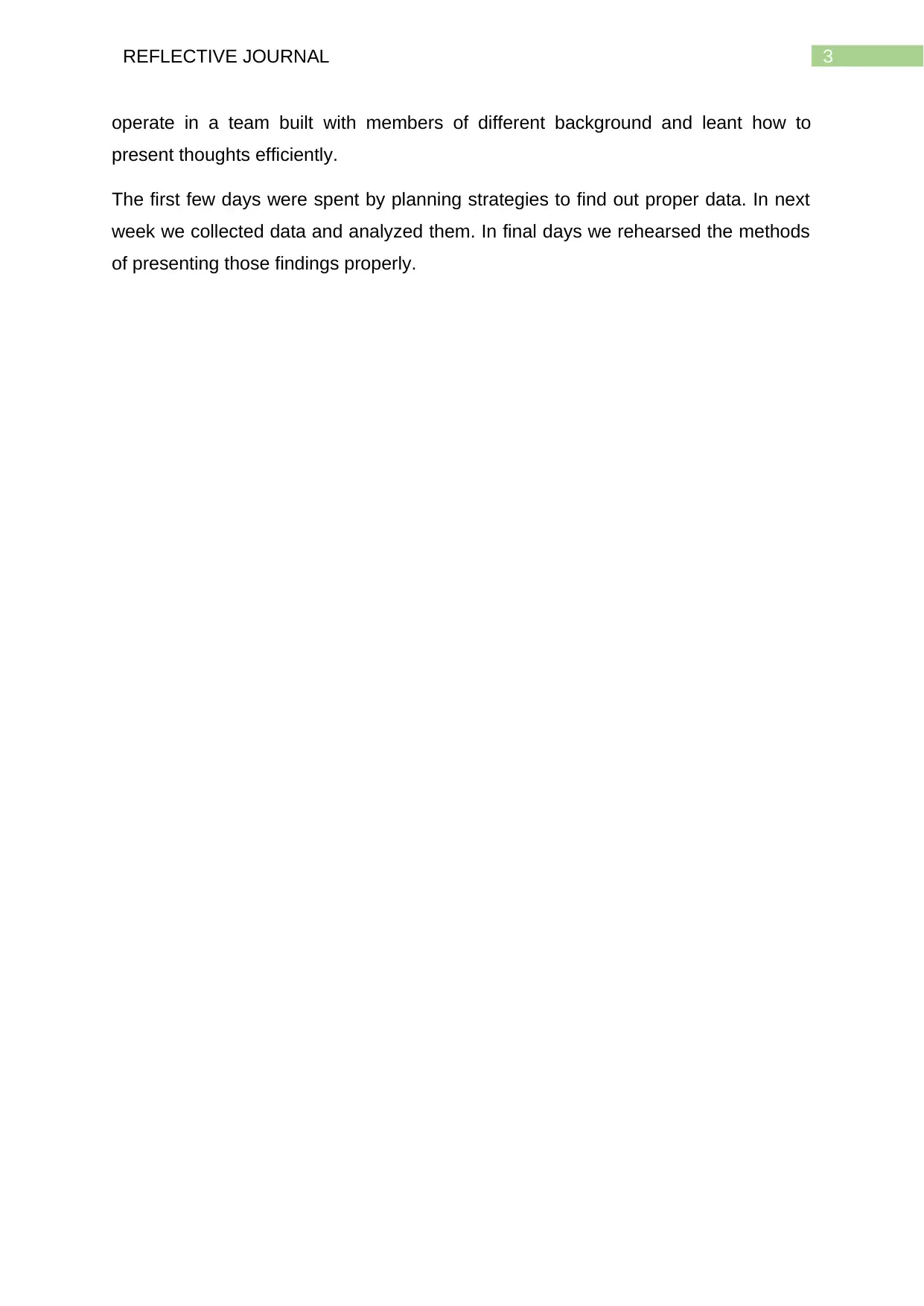
3REFLECTIVE JOURNAL
operate in a team built with members of different background and leant how to
present thoughts efficiently.
The first few days were spent by planning strategies to find out proper data. In next
week we collected data and analyzed them. In final days we rehearsed the methods
of presenting those findings properly.
operate in a team built with members of different background and leant how to
present thoughts efficiently.
The first few days were spent by planning strategies to find out proper data. In next
week we collected data and analyzed them. In final days we rehearsed the methods
of presenting those findings properly.
Paraphrase This Document
Need a fresh take? Get an instant paraphrase of this document with our AI Paraphraser
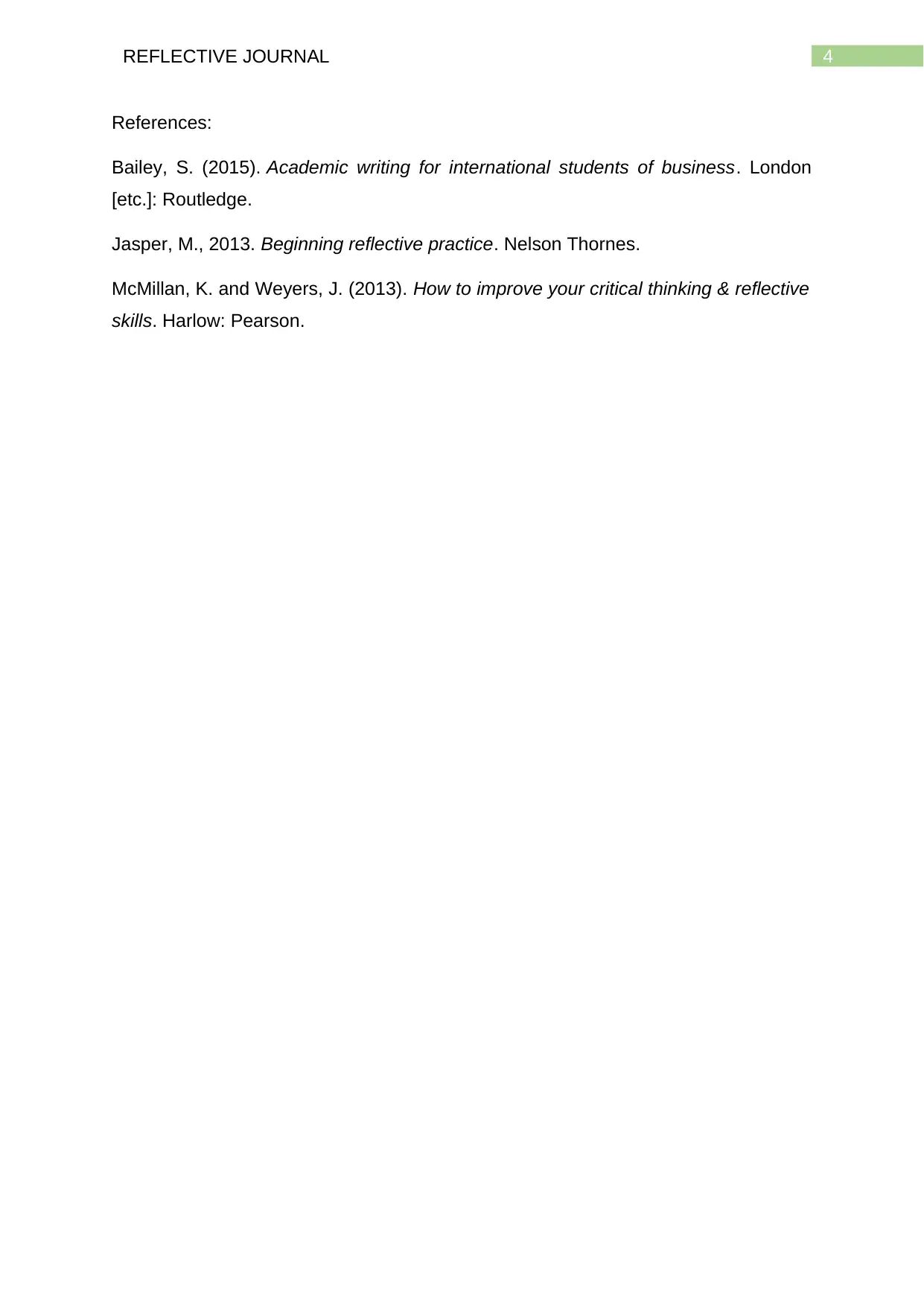
4REFLECTIVE JOURNAL
References:
Bailey, S. (2015). Academic writing for international students of business. London
[etc.]: Routledge.
Jasper, M., 2013. Beginning reflective practice. Nelson Thornes.
McMillan, K. and Weyers, J. (2013). How to improve your critical thinking & reflective
skills. Harlow: Pearson.
References:
Bailey, S. (2015). Academic writing for international students of business. London
[etc.]: Routledge.
Jasper, M., 2013. Beginning reflective practice. Nelson Thornes.
McMillan, K. and Weyers, J. (2013). How to improve your critical thinking & reflective
skills. Harlow: Pearson.
1 out of 5
Related Documents
Your All-in-One AI-Powered Toolkit for Academic Success.
+13062052269
info@desklib.com
Available 24*7 on WhatsApp / Email
![[object Object]](/_next/static/media/star-bottom.7253800d.svg)
Unlock your academic potential
Copyright © 2020–2025 A2Z Services. All Rights Reserved. Developed and managed by ZUCOL.





